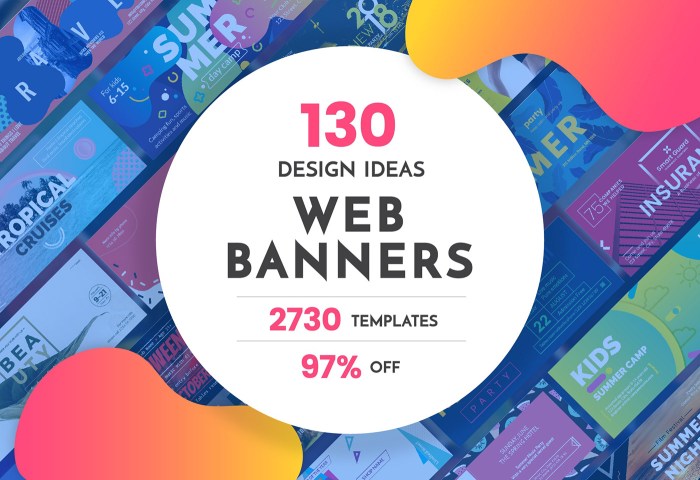Designing Effective Web Banners sets the stage for captivating online advertising. Dive into the world of web banner creation with essential tips and tricks to make your banners stand out from the crowd.
Explore the key elements, design principles, and expert tips to craft compelling web banners that drive user engagement and boost marketing campaigns.
Understanding Web Banners
Web banners are graphic images displayed on websites to promote a product, service, or brand. They serve as a form of online advertising aimed at attracting the attention of website visitors and driving traffic to a specific landing page. Designing effective web banners is crucial for marketing campaigns as they are often the first point of contact between a user and a brand.
A well-designed banner can capture the audience’s interest, convey a message, and encourage them to take action, such as clicking through to learn more or make a purchase.
Importance of Effective Design
- Engagement: Engaging and visually appealing banners can increase user interaction and click-through rates.
- Brand Awareness: Consistent branding and messaging in banners help reinforce brand identity and recognition.
- Call-to-Action: Clear and compelling calls-to-action in banners prompt users to take the desired action.
Sizes and Formats
- Standard Sizes: Common web banner sizes include 300×250 pixels (medium rectangle), 728×90 pixels (leaderboard), and 160×600 pixels (wide skyscraper).
- Formats: Web banners can be static (JPEG, PNG) or animated (GIF, HTML5) to create interactive and dynamic content.
- Responsive Design: With the rise of mobile browsing, responsive web banners adapt to different screen sizes for optimal viewing on various devices.
Elements of Effective Web Banners

When it comes to creating impactful web banners, there are several essential elements that should be included in the design to attract users and drive engagement.Engaging Visuals, Typography, and Colors:
Visuals
Visuals play a crucial role in capturing the attention of users. High-quality images or graphics that are relevant to the message being conveyed can make a web banner more appealing and memorable.
Typography
The choice of typography can greatly impact the readability and overall aesthetic of a web banner. Using clear, easy-to-read fonts that complement the design can enhance the message and ensure that it is effectively communicated to the audience.
Colors
Colors have the power to evoke emotions and influence user behavior. Selecting a color scheme that aligns with the brand identity and message of the banner is essential. Vibrant colors can attract attention, while a cohesive color palette can create a sense of harmony and professionalism.Clear Call-to-Action (CTA):
Call-to-Action, Designing Effective Web Banners
A clear and compelling call-to-action is crucial for driving user interaction. The CTA should clearly communicate the desired action that users are expected to take, whether it’s making a purchase, signing up for a newsletter, or exploring more content. Using actionable language and placement that stands out can motivate users to engage with the banner.By incorporating engaging visuals, typography, colors, and a clear call-to-action, web banners can effectively capture the attention of users and drive meaningful interactions.
Design Principles for Web Banners
Creating effective web banners requires a good understanding of design principles. These principles include balance, contrast, alignment, and repetition. By applying these principles correctly, you can create visually appealing banners that effectively convey your message to the audience.
Balance
Balance in web banners refers to the distribution of elements within the banner. A well-balanced banner will have visual symmetry and harmony, making it more pleasing to the eye. This can be achieved by evenly distributing elements such as text, images, and white space throughout the banner.
Contrast
Contrast is essential in making certain elements stand out in a web banner. By using contrasting colors, fonts, or sizes, you can draw attention to important information or calls to action. This helps create visual interest and directs the viewer’s focus to key elements within the banner.
Alignment
Alignment ensures that all elements in the web banner are visually connected and organized. Proper alignment of text, images, and other elements helps create a cohesive and professional look. It also improves readability and makes the banner easier to navigate for the viewer.
Repetition
Repetition involves using consistent design elements throughout the web banner. This could be repeating colors, fonts, shapes, or patterns to create a sense of unity and reinforce brand identity. Repetition helps establish visual consistency and aids in reinforcing the message or branding.
Maintaining Visual Hierarchy and Readability
To maintain visual hierarchy in web banners, you should prioritize important elements by making them larger, bolder, or more prominent. This helps guide the viewer’s eye and ensures that the most critical information is noticed first. Additionally, maintaining readability involves using legible fonts, appropriate font sizes, and proper spacing to ensure that the message is clear and easy to understand.
Tips for Creating Compelling Web Banners: Designing Effective Web Banners

Creating web banners that grab attention and drive engagement is crucial for the success of any online campaign. Here are some tips to help you optimize your designs for different devices, conduct A/B testing for refinement, and tailor your banners to target audience preferences.
Optimizing Web Banners for Different Devices and Screen Sizes
When designing web banners, it’s essential to consider the various devices and screen sizes that your audience may be using. Make sure your banners are responsive and can adapt to different resolutions and display sizes. Keep the text concise and legible, use high-quality images that load quickly, and ensure important information is prominently displayed even on smaller screens.
Importance of A/B Testing and Iteration
A/B testing involves creating multiple versions of a web banner and testing them to see which performs better in terms of click-through rates and conversions. By analyzing the results of these tests, you can refine your design elements, messaging, and calls-to-action to improve performance over time. Continuously iterating based on data-driven insights will help you create more effective web banners that resonate with your audience.
Understanding the Target Audience and Tailoring Web Banners
To create compelling web banners, it’s crucial to understand your target audience’s preferences, interests, and behavior. Conduct research to identify their demographics, psychographics, and online habits. Tailor your banners to speak directly to their needs and desires, using language, visuals, and offers that resonate with them. By personalizing your banners based on audience insights, you can increase engagement and drive conversions effectively.
